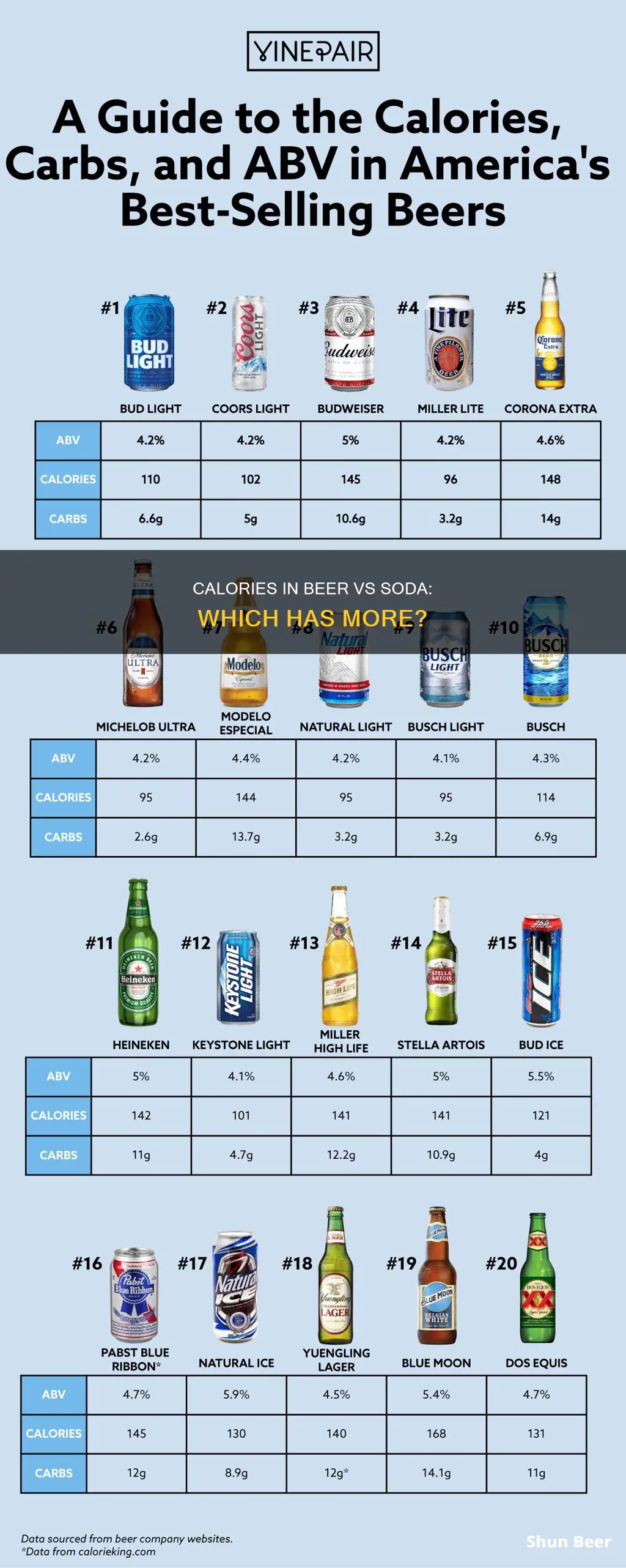
Beer and soda are both popular drinks, but which has more calories? A 12-ounce can of beer typically contains around 100 to 150 calories, depending on the type and alcohol content. Light beers have fewer calories, ranging from 60 to 100 calories, while regular beers usually contain 140 to 180 calories. On the other hand, a 12-ounce can of soda generally has about 125 to 180 calories, derived entirely from sugar. While beer has more calories than soda, it also provides some vitamins and minerals, such as thiamin, riboflavin, and vitamin B-12, which are absent in soda.
Beer vs Soda:
| Characteristics | Values |
|---|---|
| Calories | Beer: 60-350 (depending on alcohol content); Soda: 125-180 |
| Sugar | Beer: 1-2g; Soda: 39g |
| Nutritional Value | Beer: contains vitamins and minerals; Soda: contains none |
| Health Benefits | Beer: may have some health benefits in moderation; Soda: has no health benefits |
| Addictive Properties | Both beer and soda can cause a release of endorphins in the brain and may be addictive |
| Diseases | Both linked to liver and heart health issues; soda is also linked to diabetes |
What You'll Learn
- Beer has fewer calories than soda, but it depends on the type of beer
- Soda has more sugar than beer, with around 9 teaspoons per can
- Beer has some nutritional value, soda has none
- Beer has a lower glycemic load than soda, so it raises blood sugar less
- Both beer and soda are linked to addictive behaviour

Beer has fewer calories than soda, but it depends on the type of beer
It is a common misconception that beer is always worse for you than soda. While both drinks have their drawbacks, beer actually has fewer calories than soda. However, this does depend on the type of beer you're drinking.
A typical 12-ounce can of beer has around 100 to 150 calories, while a 12-ounce can of soda contains between 125 and 180 calories. So, if you're comparing a regular beer to a can of Coke, the beer usually has fewer calories. But, if you're drinking a craft beer or a high-alcohol beer, you could be consuming well over 200 calories in a 12-ounce pour.
The calorie content of beer varies depending on the alcohol content. Light beers typically have a lower alcohol content and fewer calories, with around 90 to 100 calories per 12-ounce serving. Regular beers have a moderate alcohol content and usually contain around 140 to 180 calories per 12-ounce serving.
Craft beers can vary significantly in alcohol content and flavour profiles, so their calorie content can range from 150 to 250 calories per 12-ounce serving. And if you're drinking a specialty or high-alcohol beer, such as an IPA or a stout, you could be consuming 200 to 350 calories or more in a 12-ounce pour.
It's worth noting that these are approximate values, and the actual calorie content of a beer can vary depending on the specific brand and recipe.
While beer may have fewer calories than soda, it's important to remember that both drinks are still high in calories and offer little to no nutritional value. If you're looking for a healthier option, it's best to choose water, unsweetened herbal tea, or another low-calorie beverage.
Additionally, it's crucial to consume both beer and soda in moderation and to be mindful of their potential health risks. Excessive alcohol consumption can lead to health problems, and regularly consuming high levels of added sugar can increase the risk of health issues such as higher blood pressure, inflammation, weight gain, diabetes, and fatty liver disease.
Calories in Oktoberfest Beer: What You Need to Know
You may want to see also

Soda has more sugar than beer, with around 9 teaspoons per can
When it comes to sugar content, soda and beer are very different. A 12-ounce can of standard soda contains about 39 grams of sugar, which is approximately 9 teaspoons. This amount of sugar far exceeds the recommended daily intake of sugar for both men and women, as advised by the American Heart Association (AHA). Regularly consuming high levels of added sugar increases the risk of serious health issues, such as higher blood pressure, inflammation, weight gain, diabetes, and fatty liver disease. These issues are linked to an increased risk of heart attack and stroke.
On the other hand, beer contains a much smaller amount of residual sugar from the fermentation process. Most of the sugar in beer comes from the natural sugars found in the grains used during brewing. During fermentation, yeast consumes a significant portion of the sugar to produce alcohol, resulting in a relatively low final sugar content. On average, a standard 12-ounce serving of regular beer contains only around 1 to 2 grams of sugar. Light beers may have slightly less sugar, while some craft or specialty beers with added ingredients might have slightly more.
Therefore, when it comes to sugar content, beer is the healthier option compared to soda. While both drinks have their drawbacks and should be consumed in moderation, choosing beer over soda can help reduce the risk of excessive sugar intake and its associated health risks.
Calories in Amber Bock Beer: Nutritional Facts and More
You may want to see also

Beer has some nutritional value, soda has none
A 12-ounce can of beer contains about 140 calories, which is roughly the same as a can of Coke. However, some beers can contain twice that amount. The calories in beer depend mostly on alcohol content and, to a lesser extent, on carbohydrates. A typical 12-ounce beer has as many calories as a can of soda, but beer also has some nutritional value. Beer is made from grains, which are healthy, and it can be part of a healthy diet if consumed in moderation.
Beer is a source of carbohydrates, with dark beers containing more carbs than light beers due to the addition of malts during the brewing process. Beer also supplies minimal protein, with light beers containing about 0.7g and regular or dark beers containing about 1.6g per 12-ounce serving.
In addition, beer contains some vitamins and minerals, including folate, niacin, magnesium, and potassium. However, it is important to note that whole foods are better sources of these nutrients, and the calories from alcohol do not adequately provide the nutrition that the body needs.
On the other hand, soda is mostly made up of empty sugar calories. A 12-ounce can of soda contains between 125 and 180 calories, all of which come from sugar—between 8 and 11 teaspoons. This exceeds the American Heart Association's recommended daily limit for sugar. Soda has also been ranked lowest among all beverage categories for health and nutritional value.
While soda can be refreshing, it is important to be aware of its negative health effects. The liquid form of sugar in soda is particularly unhealthy because our bodies do not seem to recognize the calories as much as when they are in solid form, which can lead to overeating. Excess sugar consumption is linked to various health risks, including type 2 diabetes, obesity, and heart disease.
In contrast, beer, when consumed in moderation, may offer some potential health benefits. For example, the presence of folate in beer helps lower the risk of heart disease. Beer also reduces blood clots and has been shown to improve mental function in women and increase bone density.
Therefore, while both beer and soda contain calories, beer has some nutritional value, while soda has very little to none.
Beck's Blue Beer: Calorie Count for Health-Conscious Drinkers
You may want to see also

Beer has a lower glycemic load than soda, so it raises blood sugar less
While beer and soda are both considered unhealthy, beer has a lower glycemic load than soda, meaning it raises blood sugar less.
The glycemic index (GI) is a measure of how quickly certain foods or beverages containing carbohydrates raise blood sugar levels. A low GI drink will cause only a small rise in blood sugar levels, while high GI drinks can lead to spikes and crashes in energy levels, which are not desirable for maintaining overall health.
Soda is considered a high GI drink due to its large amounts of refined sugars and artificial ingredients that rapidly spike blood glucose concentrations when consumed. Beer, on the other hand, tends to have a lower glycemic load, despite its high GI score. The glycemic load of beer is around 11 to 20 per serving, which is considered medium. This means that while beer does raise blood sugar levels, it does so to a lesser extent than soda.
The reason for beer's lower glycemic load lies in the fermentation process. During fermentation, yeast consumes much of the sugar in beer, converting it into alcohol and carbonation. This results in a lower final sugar content compared to soda. Most of the remaining sugar in beer contributes to its flavour and body.
On average, a standard 12-ounce serving of regular beer contains around 1 to 2 grams of sugar, while a 12-ounce can of standard soda contains about 39 grams of sugar. This is significantly above the recommended daily sugar intake of 25 grams for women and 36 grams for men suggested by the American Heart Association (AHA).
While beer has a lower glycemic load than soda, it's important to note that both beverages have their drawbacks and should be consumed in moderation. Beer, for example, is higher in calories, with a typical 12-ounce beer containing around 140 to 150 calories, similar to a can of Coke. Additionally, excessive alcohol consumption can lead to health problems such as addiction and liver disease.
Calorie Count in Beer Moretti: Nutritional Facts
You may want to see also

Both beer and soda are linked to addictive behaviour
While beer and soda differ in their calorie content, they are both linked to addictive behaviour. Both drinks contain ingredients that can be addictive, such as caffeine and sugar.
Soda contains high levels of sugar, with a 12-ounce can containing about 39 grams, which is well above the recommended daily intake. Regularly consuming high levels of added sugar increases the risk of higher blood pressure, inflammation, weight gain, diabetes, and fatty liver disease. These are all linked to an increased risk of heart attack and stroke.
Beer, on the other hand, contains very little residual sugar from the fermentation process. Most of the sugar in beer comes from the natural sugars in the grains used during brewing. However, beer contains alcohol, a psychoactive substance that can impair judgment and coordination. Excessive alcohol consumption can lead to addiction, liver disease, and other health problems.
Both drinks can trigger the release of dopamine, also known as the "happy hormone". The more you drink, the less pleasure you get from the dopamine response, which can lead to dependence and increased consumption.
Symptoms of soda and beer addiction may include cravings, a lack of control over consumption, developing a tolerance, and experiencing withdrawal symptoms such as irritability and difficulty concentrating when unable to satisfy cravings.
To reduce the risk of developing an addictive response to soda or beer, it is important to consume these beverages in moderation and be mindful of their potential health risks.
Calories in Six-Pack IPA Beers: What's the Count?
You may want to see also
Frequently asked questions
A 12-ounce can of beer has about 100 to 150 calories.
A 12-ounce can of soda has between 125 and 180 calories.
Yes, the calorie content of beer varies depending on the type and alcohol content. Light beers have around 90 to 100 calories, while regular beers contain 140 to 180 calories. Craft beers can vary significantly, ranging from 150 to 250 calories or more. High-alcohol beers, such as IPAs or stouts, may contain 200 to 350 calories or more.
Yes, the calorie content of soda can vary depending on the brand. Regular soda typically contains 140 to 170 calories or more. Diet sodas, on the other hand, often have zero or minimal calories due to the use of artificial sweeteners.
While both beer and soda have their drawbacks, beer may be considered slightly healthier when comparing specific aspects such as sugar content, calories, ingredients, and acidity. However, it's important to note that neither beverage is particularly nutritious, and excessive consumption of either can have negative health consequences.







